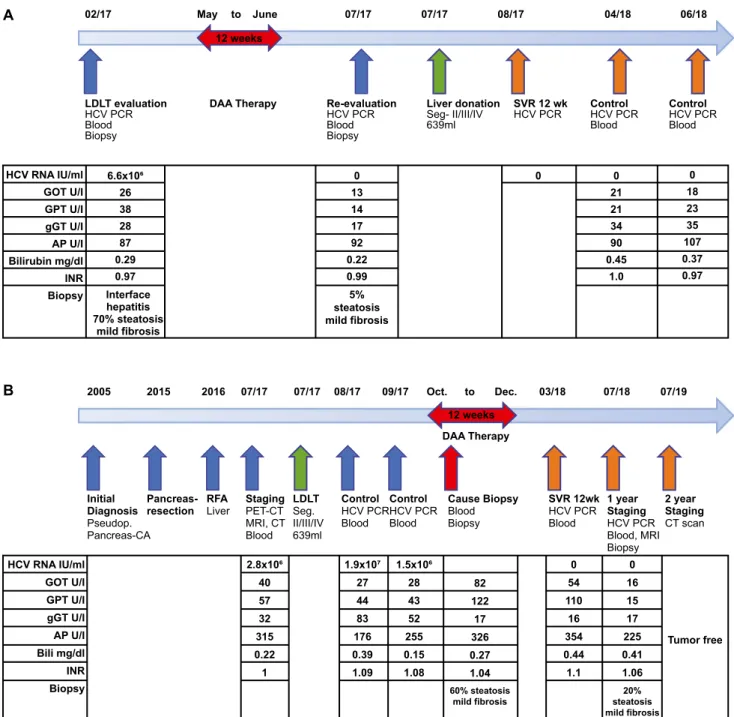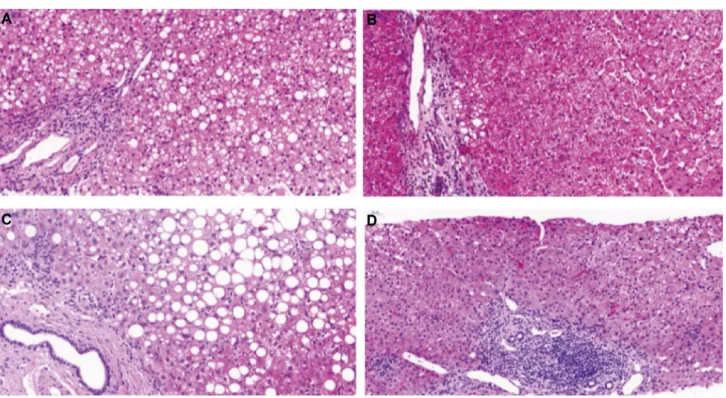1148
Hepatology, Vol. 72, No. 2, 2020
Living Donor Liver Transplantation From Hepatitis C–Infected Donor to Hepatitis C–Infected Recipient
Henrik Junger,1 Birgit Knoppke,2 Kilian Weigand,3 Katja Evert,4 Frank W. Brennfleck,1 Michael Melter,2 Hans J. Schlitt,1 and Stefan M. Brunner1
L
iving donor liver transplantation (LDLT) from hepatitis C virus (HCV)–positive donors into HCV-positive recipients is not established yet.(1) We report a case of combining direct antiviral agent (DAA) therapy and living liver donation from a donor with chronic HCV infection (genotype 3a) to a recipient with con- genital chronic HCV infection (genotype 3a).Case Report
ReCIpIeNt
The recipient, an 11-year-old female (body mass index [BMI] = 20.1 kg/m2), underwent subtotal left pancreas resection with splenectomy and partial
omentectomy due to a pseudopapillary pancreas tumor (PPT) in 2015. Because of synchronous and diffuse hepatic metastases, three transarterial chemoemboli- zations were performed 2016, but with persistent liver metastases. After extended staging, no extrahepatic manifestation of the PPT was found. Because of irre- sectability of the liver metastases, liver transplantation was indicated for complete tumor clearance.
DoNoR
Thirty-six-year-old female (mother) and daugh- ter were noncitizens in the Eurotransplant region.
Therefore, only LDLT was possible, and the mother was the only blood group match (BMI = 25.73 kg/m2, AB0 group 0, Rh+). Both donor and recipient had a chronic HCV infection. At initial evaluation, the
Abbreviations: DAA, direct antiviral agent; HCV, hepatitis C virus; LDLT, living donor liver transplantation; PPT, pseudopapillary pancreas tumor; SVR, sustained virological response.
Received November 30, 2019; accepted February 3, 2020.
© 2020 The Authors. Hepatology published by Wiley Periodicals, Inc., on behalf of American Association for the Study of Liver Diseases. This is an open access article under the terms of the Creative Commons Attribution-NonCommercial License, which permits use, distribution and reproduction in any medium, provided the original work is properly cited and is not used for commercial purposes.
View this article online at wileyonlinelibrary.com.
DOI 10.1002/hep.31185
Potential conflict of interest: Nothing to report.
aRtICle INFoRMatIoN:
From the 1Department of Surgery, University Hospital Regensburg, Regensburg, Germany; 2University Children’s Hospital Regensburg, University Hospital Regensburg, Regensburg, Germany; 3Department of Internal Medicine, University Hospital Regensburg, Regensburg, Germany; 4 Department of Pathology, University of Regensburg, Regensburg, Germany.
aDDReSS CoRReSpoNDeNCe aND RepRINt ReQUeStS to:
Stefan M. Brunner, M.D.
Department of Surgery, University Hospital Regensburg Franz-Josef-Strauss Allee 11
93053 Regensburg, Germany E-mail: Stefan.Brunner@ukr.de Tel.: +49 941 944 6801
Hepatology, Vol. 72, No. 2, 2020 JUNGER ET AL.
1149
mother had a serum viral load of 6.6 × 106 U/mL.and liver biopsy revealed an interface hepatitis with 70% steatosis hepatis (Figs. 1A and 2A). DAA ther- apy with sofosbuvir 400 mg and velpatasvir 100 mg
was initiated for 3 months. At reevaluation, the HCV viremia was cleared, and HCV remained undetectable.
Furthermore, liver enzymes were normal and the liver biopsy showed a marked reduction of the steatosis
FIg. 1. (A) Therapy timeline of the donor with LDLT evaluation, DAA therapy, re-LDLT evaluation, liver donation, and 12-week SVR control, with laboratory results and histology results. (B) Disease history and therapy overview of the recipient with initial diagnosis, initial surgical resection, and transarterial chemoembolization therapy, staging, LDLT, DAA therapy, and 12-week SVR control followed by 1-year control with laboratory and histology results. Two-year computed tomography scan shows no tumor re-occurrence. Abbreviations:
AP, alkaline phosphatase; Bili, bilirubin; CT, computed tomography; gGT, gamma-glutamyltransferase; GOT, glutamic oxaloacetic transaminase; GPT, glutamic pyruvic transaminase; INR, international normalized ratio; MRI, magnetic resonance imaging; PET, positron emission tomography; and RFA, radio frequency ablation.
$
%
Hepatology, September 2020 JUNGER ET AL.
1150
hepatis to 5% (Figs. 1A and 2B). Consequently, no contraindications for living liver donation were seen.
One year after donation, liver enzymes and cholesta- sis parameter in the donor were normal, as well as synthesis parameters, and HCV RNA was negative (Fig. 1A).
poStopeRatIVe MaNageMeNt oF lDlt
LDLT was performed using the left lobe (seg- ment II/III/IV, 693 mL) with a graft-to-bodyweight ratio of 1.6%. At transplantation, the recipient had an HCV viral load of 2.8 × 106 IU/mL. Seven weeks after transplantation, the volume of the graft increased to 1,221 mL or 91%. The HCV viral load reached its maximum of 180 × 106 IU/mL 1 month after trans- plantation. Two months later, the recipient had an HCV load of 1.5 × 106 IU/mL. DAA therapy was now initiated with sofosbuvir 400 mg and velpat- asvir 100 mg for 12 weeks. During the DAA ther- apy a liver biopsy was performed for elevated liver enzymes; it revealed no signs of rejection but a 60%
steatosis hepatis (Figs. 1B and 2C). After the DAA therapy, HCV viremia was cleared with a sustained viral response by week 12, and HCV remained unde- tectable thereafter. The 1-year protocol biopsy showed a marked reduction of steatosis hepatis to 20% and no signs of chronic liver injury (Fig. 2D). An abdom- inal magnetic resonance imaging scan 1 year after, and a computed tomography scan 2 years after, the transplantation showed no signs of tumor recurrence, neither in the bed of pancreatic resection nor in the transplanted liver.
Discussion
In the presented case, liver transplantation was indicated, as 85%-95% of patients with PPT are cured after complete tumor clearance, and success- ful liver transplantation for metastatic PPT has been reported.(2) In the era of highly effective DAAs, graft survival among HCV-positive recipients has largely increased, with outcomes comparable to non–HCV- positive recipients.(3)
FIg. 2. Liver-biopsy hematoxylin and eosin staining. (A) Donor before DAA therapy with chronic, mostly portal, but discrete interface hepatitis with a severe steatosis hepatis and mild fibrosis (1-2 Ishak score). (B) Donor after DAA therapy with only minimal steatosis hepatis and stable mild periportal fibrosis. (C) Recipient under DAA therapy also shows severe steatosis hepatis and mild fibrosis.
(D) Recipient 1-year protocol biopsy with reduced steatosis hepatis.
$ %
& '
Hepatology, Vol. 72, No. 2, 2020 JUNGER ET AL.
1151
However, little is known about living donors withchronic HCV infection. Here, once HCV remains undetectable in the donor, the liver recovers quickly from the steatosis, and living liver donation could be performed without reoccurrence of HCV after dona- tion. To monitor steatosis, we recommend an eval- uation biopsy of the donor. LDLT was done before the donor sustained virological response 12 (SVR12), due to risk of extrahepatic tumor manifestation in the recipient. If the recipient is able to wait for the donor SVR12, we recommend this for donor risk reduction.
DAA therapy of the recipient was performed suc- cessfully after LDLT, due to unknown possible effects of the DAA therapy on the tumor biology and tumor growth of this rare tumor type. Nevertheless, now, 2 years after LDLT, HCV remains undetectable and the liver function of the recipient is normal and with- out signs of tumor recurrence.
Even if a single case does not allow definitive con- clusion, the concept of antiviral DAA therapy in com- bination with LDLT in HCV-infected donors and recipients should be considered to increase the donor pool in this highly selective population. The optimal
timing for treatment of the pediatric recipient (before or after transplantation) remains to be clarified.
Author Contributions: H.J. conceptualized, drafted, and revised the manuscript. B.K. provided clinical data and reviewed the manuscript. K.E. provided pathologi- cal data and images. F.W.B. reviewed the manuscript.
K.W., M.M., and H.J.S. reviewed and edited the man- uscript. S.M.B. conceptualized, reviewed, and edited the manuscript.
ReFeReNCeS
1) Tan HP, Patel-Tom K, Marcos A. Adult living donor liver trans- plantation: who is the ideal donor and recipient? J Hepatol 2005;43:13-17.
2) Wojciak M, Gozdowska J, Pacholczyk M, Lisik W, Kosieradzki M, Cichocki A, et al. Liver transplantation for a metastatic pancreatic solid-pseudopapillary tumor (Frantz Tumor): a case report. Ann Transplant 2018;23:520-523.
3) Cotter tg, paul S, Sandikci B, Couri T, Bodzin AS, Little EC, et al. Improved graft survival after liver transplantation for recipi- ents with hepatitis C virus in the direct-acting antiviral era. Liver Transpl 2019;25:598-609.
Author names in bold designate shared co-first authorship.

